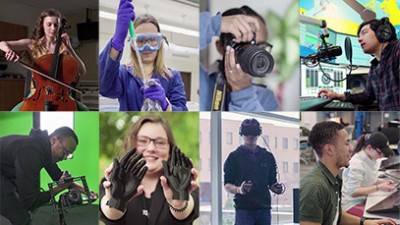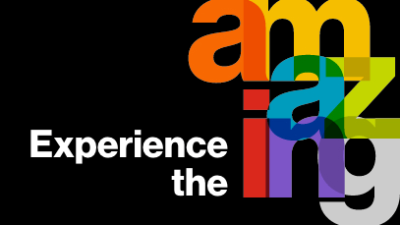Journey to the stars
RIT is becoming a renowned center for astrophysics
Joel Kastner and his team observed this planetary nebula, known as the Ant Nebula, in 2004 using the Chandra X-ray Observatory. Chandra’s data are shown in blue, while green and red are optical and infrared data from the Hubble Space Telescope. (Image credits: X-ray: NASA/CXC/RIT/J. Kastner et al.)
In the next decade, breakthroughs in astrophysics could reshape our understanding of the universe. Observations of gravity waves could prove Einstein’s theory of general relativity, or tip physics on its head. Other missions using Earth-based telescopes and space probes will pry into dark matter (an unknown material that makes up about 85 percent of the universe) and dark energy (a mysterious force linked to the expansion of the universe).
RIT is gaining a reputation in the realm of astrophysics at this exciting time, with faculty contributing to research initiatives that blend science fiction and reality.
If you weren’t looking, it might seem that astrophysics popped up overnight at RIT, complete with an internationally recognized group of scientists and a doctoral program in the works.
By its nature, astrophysics combines physics, math and imaging science, and, increasingly, computer science. It brings together scientists from different disciplines within the College of Science and the B. Thomas Golisano College of Computing and Information Sciences to explore young and dying stars, centers of galaxies and black holes, and the technology to make new observations.
“Astrophysics – the physics of the universe – is an exciting area because it touches the most challenging questions that face contemporary physics from the very small to the very large,” says David Axon, head of RIT’s Department of Physics.
Adds Ian Gatley, Dean of the College of Science: “Astrophysics is a discipline where learning by doing is absolutely key. It involves building technology, using technology and modeling phenomena using computers, and all of those are really very big issues indeed for RIT and its students.”
In the beginning
Astrophysics at RIT got a boost when Gatley joined the university in 1997 as director of the Chester F. Carlson Center for Imaging Science. Gatley, an internationally known scientist, may be best known for building one of the first multi-pixel infrared cameras used for astronomical research. While working as a lead astronomer at the National Optical Astronomy Observatories, Gatley devised a camera adapting infrared detectors from the military to point upward to penetrate the dust in interstellar space.
Gatley’s passion for adapting technology to make new kinds of measurements led to new research opportunities at RIT beginning with an initiative to process data taken from a remotely operated telescope at the South Pole and the early stages of the Stratospheric Observatory for Infrared Astronomy (SOFIA), a project that RIT’s Laboratory for Imaging Algorithms and Systems in the Center for Imaging Science is involved with today.
The ‘A’ team
By 2000, the basic foundation for astrophysics research at RIT was in place with the presence of Gatley, Joel Kastner, a world expert on planetary nebula; Zoran Ninkov, a specialist in new sensor technology for astronomical imaging; and Michael Richmond, director of the RIT Observatory. Richmond contributes to the Sloan Digital Sky Survey, a ground-based project to digitally map the sky, and the Super Nova Acceleration Probe, a future endeavor to understand the dark energy linked to the universe’s acceleration.
A core astrophysics group came together in the intervening years through the addition of seasoned scientists, internationally known and well reputed: Axon, previously affiliated with the Space Telescope Science Institute in Baltimore and the University of Hertfordshire, England, had written a paper with Gatley and knew David Merritt, an expert on galactic nuclei and black holes who came to RIT from Rutgers University. Merritt, in turn, knew Manuela Campanelli and Carlos Lousto, experts in numerical relativity simulations of black hole mergers, who, along with Yosef Zlochower, joined RIT from the University of Texas at Brownsville (see related story, page 20). Axon recruited Andrew Robinson, an expert in active galactic nuclei and polarimetry, a technique used to measure light in space, from the University of Hertfordshire, England. Manasse Mbonye, a relativistic astrophysicist specializing in theoretical cosmology and black hole physics, came to RIT from the University of Michigan and spent a year at NASA-Goddard Space Flight Center.
Axon’s connections also led Stefi Baum, now professor and director of the Carlson Center for Imaging Science, and Chris O’Dea to join RIT from the Space Telescope Science Institute, where they all had contributed to the Hubble Space Telescope. Baum had also worked with Don Figer, a leading instrumentalist in next-generation sensing technologies, at the Space Telescope Science Institute and recruited him to head the Rochester Imaging Detector Laboratory in RIT’s Center for Imaging Science.
“All the players we’ve brought in were already established in the international astronomy community and this has allowed us to create a baseline that is already recognized by our peers,” says Axon. “This was not achieved by chance, but by careful networking.”
“Of equal significance, we have recruited fine young postdocs to work with this permanent core of faculty who give momentum to the research,” he adds.
The reputations, publication records and grant-proposal writing expertise of the astrophysics faculty have helped them secure significant external funding from NASA and the National Science Foundation to support their research. Current funding totals approximately $3 million. In the last five years, these scientists have won approximately $17 million in funded research.
Astrophysics Ph.D.
Pending state approval, RIT will launch its fifth doctoral program, in astrophysical sciences and technology (AST), in fall 2008. The program will depart from traditional astrophysical studies that focus mainly on theoretical and observational aspects of the discipline by adding the characteristic RIT twist of technology and applied science. An equal emphasis on theory, observational astronomy, and sensor and instrument development will set RIT’s program apart.
Students will have the opportunity to earn masters’ and doctoral degrees in three tracks: the emerging field of astro-informatics and computational astrophysics; astronomical instrumentation and development of new technologies for application in astronomy and space science; and astrophysics. The program will draw heavily upon faculty from the Carlson Center for Imaging Science, the Department of Physics and the School for Mathematical Sciences.
“The breadth of the program we have here is extremely large,” Axon says. “We go all the way from the fundamentals of tackling Einstein’s field equations on supercomputers to how galaxies are assembled and how black holes work and grow through to the technology side of how we develop the detectors needed to make these investigations and those at the frontiers of cosmology possible.”
The RIT edge
“The AST program is a good match to RIT because of the program’s dual emphasis on the ‘end result’ – groundbreaking science and the ‘getting there’ – developing the technology required to get the science done,” says Kastner, who is on sabbatical at the Laboratoire d’Astrophysique de Grenoble in Grenoble, France. “At a place like RIT, one need not take precedence over the other. In my view, the same can’t be said for very many research university astronomy programs, where generally the emphasis is on the Ph.D. theses that represent cutting-edge science. The supporting technology is often not given the same status.”
The technological emphasis will give graduates from the AST program an edge. In addition to academic and research positions, graduates will have opportunities in a wide range of technical areas, including remote sensing, informatics, the aerospace industry, homeland security, computer technology and even business and finance.
“Astronomy is one of the oldest and most inspiring of sciences,” Baum says. “From the earliest of times, as humans gazed in awe upward in the darkness, they wondered about our place in a seemingly vast universe. They studied the changing cycle of the sun and moon and the patterns of the stars, and then applied that knowledge to meter time, measure distance, and navigate over land and sea. Astrophysics has that same reach today and we have the opportunity to expose all of RIT, from the undergraduates to our alumni, to the excitement that comes from participating in the quest to understand the cosmos.”














